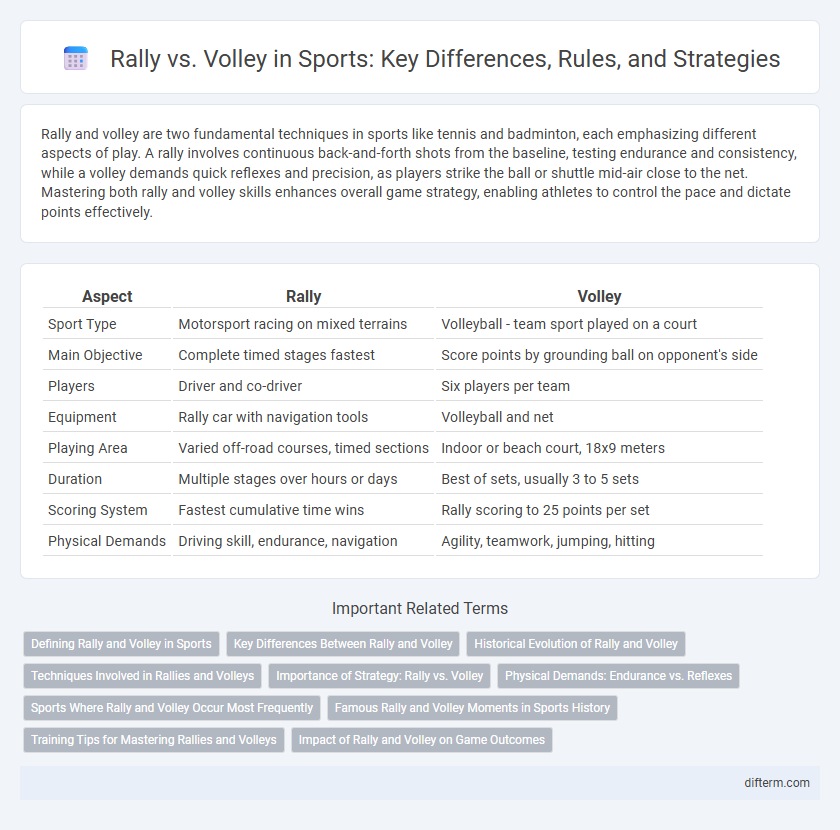Rally and volley are two fundamental techniques in sports like tennis and badminton, each emphasizing different aspects of play. A rally involves continuous back-and-forth shots from the baseline, testing endurance and consistency, while a volley demands quick reflexes and precision, as players strike the ball or shuttle mid-air close to the net. Mastering both rally and volley skills enhances overall game strategy, enabling athletes to control the pace and dictate points effectively.
Table of Comparison
| Aspect | Rally | Volley |
|---|---|---|
| Sport Type | Motorsport racing on mixed terrains | Volleyball - team sport played on a court |
| Main Objective | Complete timed stages fastest | Score points by grounding ball on opponent's side |
| Players | Driver and co-driver | Six players per team |
| Equipment | Rally car with navigation tools | Volleyball and net |
| Playing Area | Varied off-road courses, timed sections | Indoor or beach court, 18x9 meters |
| Duration | Multiple stages over hours or days | Best of sets, usually 3 to 5 sets |
| Scoring System | Fastest cumulative time wins | Rally scoring to 25 points per set |
| Physical Demands | Driving skill, endurance, navigation | Agility, teamwork, jumping, hitting |
Defining Rally and Volley in Sports
A rally in sports refers to a continuous sequence of back-and-forth shots between players, typically seen in tennis, badminton, and table tennis, where the ball or shuttlecock remains in play until a point is scored. A volley involves striking the ball or shuttlecock before it touches the ground, commonly executed near the net to quickly return the opponent's shot in tennis and badminton. Understanding the distinction between rally and volley is crucial for mastering timing and positioning in racket sports.
Key Differences Between Rally and Volley
Rally involves sustained exchanges where players hit the ball back and forth, aiming to outlast the opponent through strategic placement and endurance. Volley refers to striking the ball before it hits the ground, emphasizing quick reflexes and offensive positioning near the net. The key difference lies in rally emphasizing extended play and consistency, while volley focuses on aggressive, instantaneous ball contact.
Historical Evolution of Rally and Volley
Rally and volley are two fundamental techniques that have evolved distinctly within the history of racquet sports, particularly in tennis. Rallying originated as players exchanged baseline shots, emphasizing endurance and strategic placement, while volleying developed as an aggressive approach near the net, prioritizing quick reflexes and shot precision. The historical evolution of these styles reflects changes in court surfaces, racquet technology, and player conditioning, shaping modern gameplay strategies and competitive dynamics.
Techniques Involved in Rallies and Volleys
Rallies in tennis demand consistent baseline techniques, emphasizing groundstrokes like forehands and backhands for sustained ball exchanges across the court. Volleys require precise net skills, including quick reflexes and controlled wrist movements to intercept and redirect the ball before it bounces. Mastery of footwork and anticipation enhances both rally endurance and volley effectiveness, critical for strategic point construction.
Importance of Strategy: Rally vs. Volley
Effective strategy in rally versus volley tennis significantly impacts match outcomes by optimizing shot selection and court positioning. Rallying demands consistent baseline play and endurance, while volleying emphasizes quick reflexes and net control to shorten points. Mastery of strategic transitions between rally and volley styles confers competitive advantages in various match scenarios.
Physical Demands: Endurance vs. Reflexes
Rally in sports like tennis or badminton requires sustained endurance to maintain consistent performance over long exchanges, demanding cardiovascular stamina and muscular resilience. Volleying emphasizes rapid reflexes and explosive power to respond swiftly to fast-paced shots, relying on quick hand-eye coordination and agility. Athletes excelling in rally build prolonged stamina, while those mastering volley develop sharp, instantaneous reactions.
Sports Where Rally and Volley Occur Most Frequently
Rally and volley occur most frequently in racket sports such as tennis and badminton, where players engage in prolonged exchanges of shots and rapid net play, respectively. Tennis features rallies as players strategically hit the ball back and forth from the baseline, while volleying is concentrated near the net for quick point finishes. Badminton also incorporates extended rallies and fast-paced volleys, making these sports prime examples of where rally and volley skills are most prominently showcased.
Famous Rally and Volley Moments in Sports History
The 2019 Wimbledon final between Novak Djokovic and Roger Federer featured one of the longest and most intense rallies in tennis history, lasting over 20 shots and showcasing exceptional endurance and precision. Volleyball's 2016 Olympic final highlighted an epic rally between Brazil and Italy, stretching over 25 seconds and demonstrating rapid reflexes and teamwork under immense pressure. These iconic moments exemplify the thrilling dynamics and skill involved in both rally and volley plays across sports disciplines.
Training Tips for Mastering Rallies and Volleys
Effective training for mastering rallies involves improving endurance, footwork, and consistent shot accuracy to maintain prolonged exchanges. Volleys require sharp reflexes, strong hand-eye coordination, and practicing quick net approaches to dominate fast-paced exchanges. Incorporating drills that simulate real-game scenarios enhances both rally stamina and volley precision, optimizing overall court performance.
Impact of Rally and Volley on Game Outcomes
Rally in sports, especially in tennis and badminton, emphasizes consistency, endurance, and strategic shot placement, often leading to extended exchanges that can wear down opponents and shift momentum. Volley, characterized by quick reflexes and aggressive net play, can shorten points and force errors, offering an advantage in controlling the pace and pressure during critical moments. The balance between rally endurance and volley aggression significantly influences match outcomes by dictating player tactics and psychological dynamics.
rally vs volley Infographic

 difterm.com
difterm.com